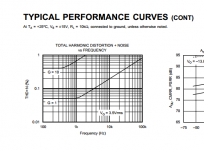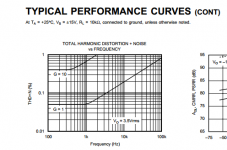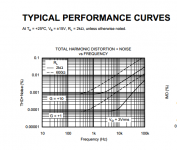No thoughts anyone?
I've pulled the breadboarded VSPS to start building it properly, so can't test now, but one thought was that the distortion MIGHT sound like clipping (but I was playing through a 1.5wpc SE tube amp from which I've never heard clipping, even turned all the way up with a CDP signal.
If it's clipping, I think it may be coming from the VSPS as it's obvious clipping much the way solid state clips (vs tube clipping). But again, I'm only at 40+ dB gain with a 1.5mV TT signal. Can't understand how that would result in clipping in the VSPS.
So, again, any thoughts about the distortion and about running OPA2137/4 at 18-20vDC?
I've pulled the breadboarded VSPS to start building it properly, so can't test now, but one thought was that the distortion MIGHT sound like clipping (but I was playing through a 1.5wpc SE tube amp from which I've never heard clipping, even turned all the way up with a CDP signal.
If it's clipping, I think it may be coming from the VSPS as it's obvious clipping much the way solid state clips (vs tube clipping). But again, I'm only at 40+ dB gain with a 1.5mV TT signal. Can't understand how that would result in clipping in the VSPS.
So, again, any thoughts about the distortion and about running OPA2137/4 at 18-20vDC?
Huh, no I haven't. I've never had a problem with opamps failing so it didn't occur to me to try that (I don't use opamps very often). I think I have another 2137 so 'll try that when I can. I don't want to try with a better opamp until I get the kinks worked out.
Thanks for the idea.
On another note, I just tried to download the PCB/schematic from Richard's website but it won't open in Eagle editor on a Mac. Anyone able to do that? I'll probably PM him as I'm considering just purchasing a board anyway, despite my miserly...uh...thrifty tendencies.
Thanks for the idea.
On another note, I just tried to download the PCB/schematic from Richard's website but it won't open in Eagle editor on a Mac. Anyone able to do that? I'll probably PM him as I'm considering just purchasing a board anyway, despite my miserly...uh...thrifty tendencies.
Sorry for the late reply...
First off, if the datasheet says,
ABSOLUTE MAXIMUM RATING Supply Voltage, V+ to V– ..................................................................... 36V
you don't operate the op amp above nominal +/-15 V rails.
Second, if the harmonic distortion plot looks as bad as they do for the OPA2137 you drop the part for the candidate list.
(Pro Tip: do not even consider an op amp when the datasheet lists "low cost" as the headline feature, and does not mention audio in the list of applications.)
Please use NE5532 or OPA2134, and power with +/-9 V rails, not +/-18 V.
[It pains to even look at that THD plot, as it forces me to imagine just how awful it would sound. Multiply the G=10 line by 10 (your gain is 40 dB or 100x) and mentally extrapolate the line out to 20 kHz. THD+N = 80%! Ou-ch!]
First off, if the datasheet says,
ABSOLUTE MAXIMUM RATING Supply Voltage, V+ to V– ..................................................................... 36V
you don't operate the op amp above nominal +/-15 V rails.
Second, if the harmonic distortion plot looks as bad as they do for the OPA2137 you drop the part for the candidate list.
(Pro Tip: do not even consider an op amp when the datasheet lists "low cost" as the headline feature, and does not mention audio in the list of applications.)
Please use NE5532 or OPA2134, and power with +/-9 V rails, not +/-18 V.
[It pains to even look at that THD plot, as it forces me to imagine just how awful it would sound. Multiply the G=10 line by 10 (your gain is 40 dB or 100x) and mentally extrapolate the line out to 20 kHz. THD+N = 80%! Ou-ch!]
Attachments
Last edited:
Sorry for the late reply...
First off, if the datasheet says,
ABSOLUTE MAXIMUM RATING Supply Voltage, V+ to V– ..................................................................... 36V
you don't operate the op amp above nominal +/-15 V rails.
Second, if the harmonic distortion plot looks as bad as they do for the OPA2137 you drop the part for the candidate list.
(Pro Tip: do not even consider an op amp when the datasheet lists "low cost" as the headline feature, and does not mention audio in the list of applications.)
Please use NE5532 or OPA2134, and power with +/-9 V rails, not +/-18 V.
[It pains to even look at that THD plot, as it forces me to imagine just how awful it would sound. Multiply the G=10 line by 10 (your gain is 40 dB or 100x) and mentally extrapolate the line out to 20 kHz. THD+N = 80%! Ou-ch!]
Yes, I know what the datasheet says. I also know that many people report running parts above their rated max with no problems. Particularly true of tubes, but also of opamps. I understand there's no guarantee, but I was looking for first-hand experience doing it, which I feel pretty sure exists out here on DIYAudio. I willingly take the risk, but was hoping for others' experience to help me make sense of the risk.
That said, for now I'll try one 9v battery. I am likely to eventually build a mains PS for it, but I'm trying to learn all I can about this amp.
As for distortion, I was going on the info presented on the HagTech website for the Bugle phono stage (also opamp), which suggests the 2137 as a higher noise but lower current draw opamp relative to the 2134 (otherwise the same). I'm using it only to test the VSPS concept to myself - I'll use 2134, 2111, 2604 and 2107 when I get it going to my satisfaction.
*** (see edit below) When I look at the datasheets, I see 0.12% or so at 20k for the 2137. Assuming that's reasonably accurate, relative to tube performance that's pretty good. I realize tube distortion is different from opamp distortion, but I don't have enough experience yet to make sense out of the numbers. So I figured 2137 would be OK as a test opamp.
So maybe my distortion, if that's what I heard, is in part due to the part (the 2137) and in part to the high PS voltage. (Note, though, for now mine was probably running at +/- 17v or so as the batteries are somewhat worn down. I know their current capacity drops pretty quickly as they drop below the nominal voltage so that may also be contributing to potential problems.
***Er, now I see, the G=10 has to be multiplied by 4 to get to 40dB, so I see the distortion you're talking about. Uh, I'm a little slow to these things. Thanks for pointing that out!
Last edited:
Yes, I know what the datasheet says. I also know that many people report running parts above their rated max with no problems.
What part of the phrase "ABSOLUTE MAXIMUM" suggests to you that exceeding them is a good idea? I mean, seriously. Think about this for a moment: Even if it doesn't go up in smoke at the outset, you are looking at reduced lifetime, and degraded performance...
(it's not even a good idea with tubes, as again, only stripped cathodes and dramatically reduced lifetime await you. Note that there is a world of difference between the recommended operating points and the absolute maximum values...)
***Er, now I see, the G=10 has to be multiplied by 4 to get to 40dB, so I see the distortion you're talking about. Uh, I'm a little slow to these things. Thanks for pointing that out!
You are now on the right track, but G=10 is 20 dB, while 40 dB is G=100. The multiple is 10 not 4, so distortion is 2.5x worse than even your last best estimate...
Are they really suggesting the OPA2137 for audio over at HagTech? I find it difficult to believe. It's nothing at all like the OPA2134.
Many audio op amps are rated to V+ to V- = 44~46 V. If you use them, then running at +\-18 V is possible though not really recommended. My own evaluation points to the sweet spot being +/- 8~11 V.
Last edited:
Opamps dissipate more power when run at higher voltages.
Many opamps run a higher quiescent current when supply voltage is higher. This makes the higher voltage dissipation even worse.
A dual in dip8 has the same surface area as a single in dip8.
The dual will run hotter.
A 5534 will run with +-22Vdc supply for a long time, if you ensure the output load is reasonable. A clip on sink will probably increase reliability.
Any dual in dip8 will probably have a short life if you run it at >+-18Vdc, even with a clip on sink.
Many opamps run a higher quiescent current when supply voltage is higher. This makes the higher voltage dissipation even worse.
A dual in dip8 has the same surface area as a single in dip8.
The dual will run hotter.
A 5534 will run with +-22Vdc supply for a long time, if you ensure the output load is reasonable. A clip on sink will probably increase reliability.
Any dual in dip8 will probably have a short life if you run it at >+-18Vdc, even with a clip on sink.
What part of the phrase "ABSOLUTE MAXIMUM" suggests to you that exceeding them is a good idea? I mean, seriously. Think about this for a moment: Even if it doesn't go up in smoke at the outset, you are looking at reduced lifetime, and degraded performance...
(it's not even a good idea with tubes, as again, only stripped cathodes and dramatically reduced lifetime await you. Note that there is a world of difference between the recommended operating points and the absolute maximum values...)
You are now on the right track, but G=10 is 20 dB, while 40 dB is G=100. The multiple is 10 not 4, so distortion is 2.5x worse than even your last best estimate...
Are they really suggesting the OPA2137 for audio over at HagTech? I find it difficult to believe. It's nothing at all like the OPA2134.
Many audio op amps are rated to V+ to V- = 44~46 V. If you use them, then running at +\-18 V is possible though not really recommended. My own evaluation points to the sweet spot being +/- 8~11 V.
I asked about voltaqe b/c I didn't know the answer and was hoping to get feedback. Now I have your input and AndrewT's, which I appreciate. I wouldn't ever think of operating any component above spec unless I'd read numerous cases of people doing it. I don't know electronics well enough to try something like that without having read it elsewhere from people I've followed and developed respect for on forums.
The idea of doing so, though, does seem reasonable b/c I can't imagine manufacturers publish specs that are so close to the edge of failure. No doubt they've done tests suggesting that the failure rate at 18v is at a level they can tolerate. At 19v, that rate undoubtedly goes up. My real question is how fast does that failure rate go up? But I digress. My breadboarded version running at somewhere between 16 and 18v didn't even get warm.
Re: the OPA 2137, HagTech doesn't suggest the 2137 so much as offer it as a 10x lower battery draw for low to mid-gain implementations. To quote:
The recommended Burr-Brown OPA2134PA opamps are a good fit for this particular circuit. However, they will discharge the batteries rather quickly. For a 10x improvement (160 hours), use the OPA2137PA. Beware, these are much noisier devices and should not be used for high gain stages.
I see. Well at least they give you some warning I guess. Not just noise, but also distortion, and, frankly, any audio-related characteristics are so bad though I cannot recommended it even for low gain applications.
At unity gain, the OPA134 into 600 ohms is ~700 times lower THD+N than the OPA2137 into 10 kohms.
If that's not "ownd", I don't know what is...
At unity gain, the OPA134 into 600 ohms is ~700 times lower THD+N than the OPA2137 into 10 kohms.
If that's not "ownd", I don't know what is...
Attachments
I see. Well at least they give you some warning I guess. Not just noise, but also distortion, and, frankly, any audio-related characteristics are so bad though I cannot recommended it even for low gain applications.
At unity gain, the OPA134 into 600 ohms is ~700 times lower THD+N than the OPA2137 into 10 kohms.
If that's not "ownd", I don't know what is...
Right, and it's not like we're talking about an $80 power triode here... Even the 2134 goes for pretty short money. BTW, got your email.
I don't hear so much feedback about the VSPS300, and unlike the phonoclone I don't use one myself, so its nice to learn that people are happy with it.
I've been using a VSPS300 for some time now. I love it! It has, in combination with my Rega P5/Sumiko Bluepoint III, a wonderful soundstage, great bass, mids, highs and dynamics! I changed some resistors as discussed earlier in this thread to get some more gain. The VSPS300 is just the right thing in my set!
The kit is easy to build, instructions are clear. I'm happy!
I've been using a VSPS300 for some time now. I love it! It has, in combination with my Rega P5/Sumiko Bluepoint III, a wonderful soundstage, great bass, mids, highs and dynamics! I changed some resistors as discussed earlier in this thread to get some more gain. The VSPS300 is just the right thing in my set!
The kit is easy to build, instructions are clear. I'm happy!
I am running my BlackBird through the PhonoClone 3 with great success. I built both just to see and the PC 3 was far better. No issues after a couple of years. You might like it.
I don't know the BlackBird but as far as I know the Bluepoint III is a high-output cartridge. Isn't the PhonoClone 3 a bit to much for the Bluepoint III?
The Blackbird is Sumiko's step up from your cart. It too is a high output moving coil design. Output is 2.5MV. Works a charm with the Phonoclone!
- Home
- Source & Line
- Analogue Source
- The Phonoclone and VSPS PCB Help Desk


